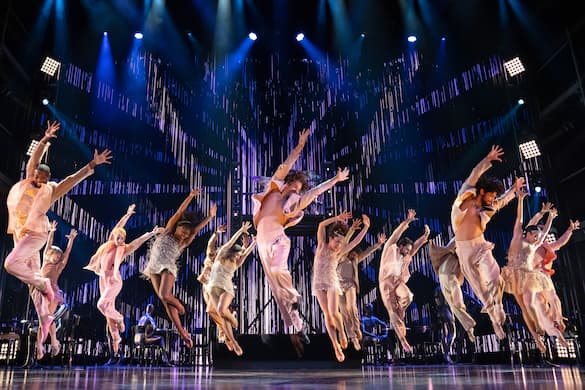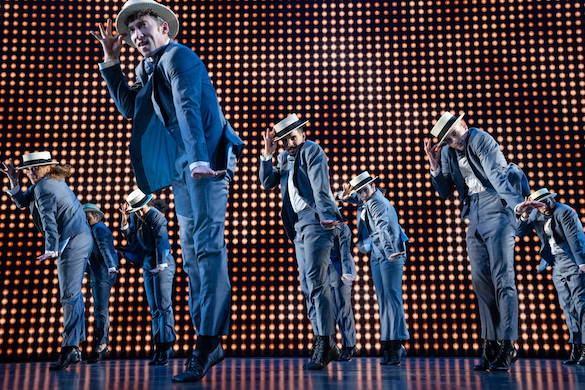Revival of Bob Fosse’s 1978 Revue Runs More Like an Homage
The new production is directed and musically staged by one of its original cast members, Wayne Cilento, who has added songs and updated orchestrations as well as new sequences to the visionary choreographer and director’s original.

Dance may well be the most demanding and all-consuming of the performing arts. Those who pursue it seriously must be both actors and athletes, and the best have as keen an affinity for musical expression as any singer or instrumentalist. The difference is that, for dancers, the entire body becomes the instrument, so that no part of it — from the toes to the hips to the eyeballs to the top of the head — is inconsequential.
No one understood this better than Bob Fosse, the visionary choreographer and director whose credits read like a guide to some of the most adventurous and accessible stage musicals and films of the middle-to-late 20th century: “The Pajama Game,” “Sweet Charity,” “Pippin,” “Chicago,” and “All That Jazz,” to name a few. Some casual fans would reduce Fosse’s style to jazz hands and sexy thrusts, but the technical and emotional range of his work was far wider than that.
The actress and dancer Bebe Neuwirth, who worked with Fosse shortly before his death and has remained an active champion, explained it beautifully when I interviewed her for a book about “Pippin,” noting, “It can be very internal, and quite profound. There’s humor and there’s eccentricity and there’s irony — irony not just intellectually but physically…. There is dark and light at all times, and many, many shades in between.”
These qualities are on display in “Bob Fosse’s Dancin’,” a new production of Fosse’s epic 1978 revue directed and musically staged by one of its original cast members, Wayne Cilento. Mr. Cilento’s version has been substantially revised; though its running time is shorter, at roughly two and a quarter hours (including an intermission), there are additional songs and updated orchestrations as well as new sequences, among them a tribute to Fosse’s last original musical, 1986’s “Big Deal,” in which Mr. Cilento also appeared.
“Big City Mime,” a ballet cut from the original production, has been reassembled by Mr. Cilento — whose own credits as a choreographer include “Wicked,” “The Who’s Tommy,” and a 2004 revival of “Sweet Charity” — with nods to iconic routines from shows mentioned above and other Fosse projects. There’s also a fair amount of spoken text, from exchanges between characters to monologues and Fosse’s own words, reproduced both in archival voiceover and by the performers.

The result is less a revival than a blazing homage — a word that might have made Fosse, known to those close to him as much for his driving insecurity and often humble demeanor as his renowned ego, blush, or even wince a bit. The design has a flamboyantly cinematic feel, acknowledging Fosse’s work in that medium; Robert Brill’s set uses scaffolding to evoke settings from a state penitentiary to a massage salon, with David Grill’s lighting placing the dancers and scenery against bold primary colors.
The dancin’ itself reminds us that for all the emphasis on the meticulousness and nuance of Fosse’s choreography, it could also be explosively athletic and unapologetically exuberant. An early number, “Percussion,” sets off a series of acrobatic fireworks, segueing from a movement featuring three gyrating performers and a pugilistic vibe to another in which Ron Todorowski — one of the more than 20 lavishly talented ensemble members — hurls through several gravity-defying fake endings before finally leaving in a witty flourish.
You don’t have to know the difference between a pirouette and a time step to appreciate all that follows: the dazzling isolations, the mix of clean lines and naughty (but never vulgar) innuendo, the sense of control and release that no musical theater choreographer has captured more excitingly. The bowler hats that became Fosse’s trademark figure into numerous routines, and now and again, someone lights a cigarette in solidarity with his spirit.
Where Fosse was known for favoring tall, leggy women — on stage and off — Mr. Cilento has summoned the variety in body type and personality he truly sought for his character-driven pieces, with a contemporary emphasis on racial, ethnic, and gender diversity. (Fosse’s own defiance of racism and war inform a few sequences.) Some dancers, like Manuel Herrera and Khori Michelle Petinaud, are also fine, strong singers; true triple threats — the theater term for performers who can sing, dance, and act with equal or similar facility — are more common these days than they were in Fosse’s time.
For the curtain call, Mr. Cilento has allowed everyone in the company a solo, signature bow, one that seems as expressive of personal style as it is of Fosse’s enduring influence. It’s a fitting way to wrap a celebration of a man for whom dancers were both actors and unique individuals, whether they were marquee names or chorus members, and for whom bold gestures always carried a purpose.

